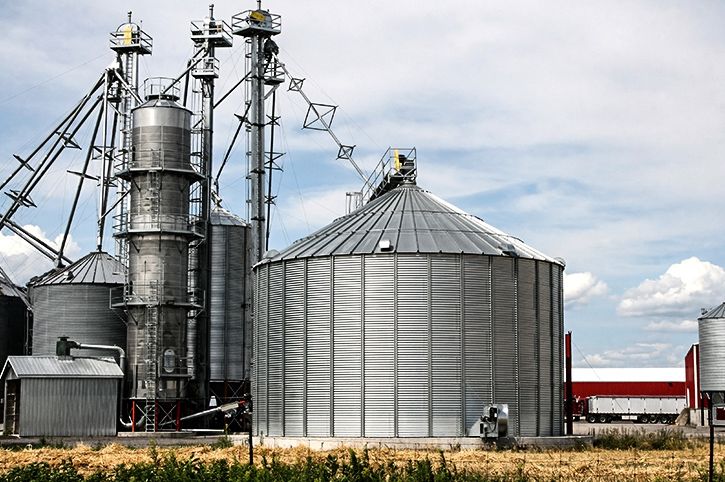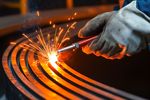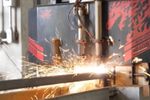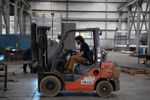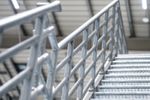Water – we can’t live without it, especially when it comes to growing crops, but it’s moisture that can destroy an entire harvest if it seeps into a silo, hopper, or other grain storage system. Maintaining proper moisture is critical; it only takes 12 percent moisture content inside a storage container to develop condensation that leads to grain caking.
Moisture also causes rust, which can inflict serious damage to any steel feed & grain storage system. Just one spot of old, chipped paint can allow rust to seep in and compromise the integrity of the entire storage unit.
Fortunately, there are steel detailing techniques that can help protect the integrity of these steel structures, even during extreme climate changes that expose steel to water and fluctuating temperatures.
Hot-Dip Galvanizing
One of the most cost-effective steel detailing techniques to protect silos, hoppers, and other feed & grain storage systems is hot-dip galvanizing (HDG), which coats the metal in corrosion-resistant zinc.
Also referred to as batch or after-fabrication galvanizing, hot-dip galvanizing includes:
- Cleaning the fabricated metal surface to remove grease, oils, and mill scale
- Dipping the metal into a kettle of molten pure zinc and additives to ensure the coating surrounds every edge and crevice
- Waiting for the zinc bath to react to the steel at a metallurgic level and form the corrosion-protective coating
Note that before initiating HDG, it’s critical to assess the structural condition of a steel hopper or silo to take into account any existing strain-age embrittlement or working parts that may experience undue friction. After HDG, welding must be performed with care to avoid damaging the zinc coating.
Welding Considerations
If welding isn’t performed with HDG in mind, the welds may not hold during the dip process. Often, steel detailing techniques such as spot or metal arc welding are required during metal fabrication to fuse silo or hopper parts together prior to galvanizing.
An experienced metal fabricator with properly certified welders will take precautions to prevent the zinc from penetrating the weld spot that can lead to cracking. A pushing weld, rather than a pulling, can help ensure the spot will remain intact during the galvanizing process.
After HDG, additional metal fabrication work must involve materials that are compatible with the zinc coating. For example, metal fasteners must be compatible and have the same or greater corrosion resistance so they don’t cause premature failure in other materials.
Also note that when welding galvanized steel, ventilation or air filtration is required, as very high temperatures on thick zinc coatings can release toxic fumes that pose respiratory threats for workers in the vicinity. For electric resistance welding, it’s important to pay close attention to the parameters and check that the electrodes don’t become too hot, which can cause a number of issues with the zinc coating.
Design Considerations
When a feed & grain steel storage system is properly designed at the beginning of the metal fabrication process, it greatly reduces the chance of structural problems when hot-dip galvanizing.
One steel-detailing consideration is the metal thickness, which can impact the functionality of sub-assemblies and components. Parts with overlapping surfaces can cause the coating to wear more quickly.
During the design phase, metal fabricators must:
- Consider the types of steel that are selected for the component or finished goods
- Understand the various metallurgical properties that can interact with the molten zinc, which we noted earlier can determine the potential for steel embrittlement or cracking
- Apply proper venting and drainage to allow the cleaning solutions and molten zinc to pass through for a consistent and even coating
A full-service metal fabricator can take all these considerations into account to create superior end products and sub-assemblies for protecting valuable feed & grain investments.
Feed & Grain Storage Fabrication for Bottom-Line Results
Metal fabricators experienced with feed & grain storage solutions can help shield your valuable product from the outdoor elements. From initial design to installation, Southern Metal Fabricators has the steel detailing know-how to help ensure your silo, hopper, or other steel storage system withstands the test of time.
Our seasoned team of experts stand ready to offer custom metal fabrication services such as:
- Design via AutoCad, MTC Shape Cutting, and Pro Nest software capabilities
- Metal cutting for almost any size or shape, from trim to I-beams
- State-of-the-art forming, including bending, shaping, and punching to ensure the metal is suitable for mass production
- Welding, fastening, or a combination of techniques to ship fabrications as assembled as possible for easy install
- Finishing, such as hot-dip galvanizing, powder coating, or simply priming and painting
- Installation for a wide variety fabrication projects, including custom bulk storage bins, silos, and hoppers
If you’re ready to partner with a custom metal fabricator that has 28 years of experience working with agriculture, feed & grain, and bulk food storage, give us a chance to say, “Yes, we can do that!” by contacting us today.
